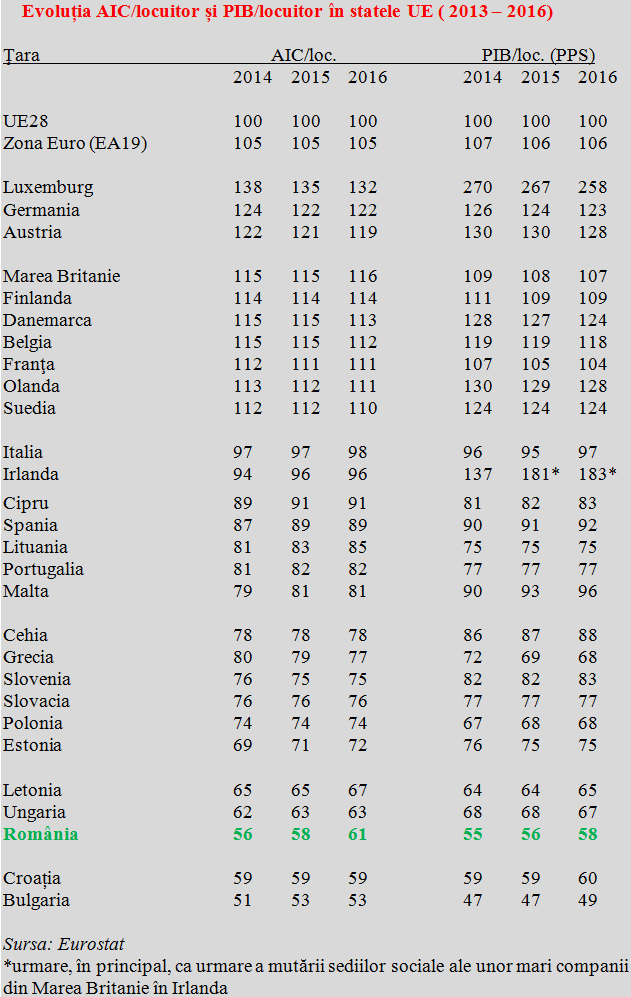 Romania has reached 61% of the average living standard in the EU 28 in 2016, according to the actual individual consumption indicator (AIC), the latest data released by Eurostat shows.
Romania has reached 61% of the average living standard in the EU 28 in 2016, according to the actual individual consumption indicator (AIC), the latest data released by Eurostat shows.
The gap between this indicator and GDP per capita, initially at a minimum level, has been increasing since 2014 and the theoretical minimum standard of living mentioned for the adoption of the euro has already been reached.
In the more familiar method of measuring living standards, which is GDP per capita at the parity of the standard of the purchasing powers, last year we were at 58% of the EU average, with the mention that these figures have been slightly adjusted downwards compared to the initial estimates of the central EU statistics body.
We went ahead Croatians and are getting closer to Hungarians
In terms of the consumption measured by AIC, our country exceeded Croatia and recorded the highest increase in this indicator in the last three years of all EU countries. Contrary to the public perception, which calls for a further substantial increase in revenue, the advance between 2014 and 2016 was no less than five percentage points.
GDP per capita compared to AIC
The actual individual consumption (abbreviated AIC in English) reflects more accurately the well-being of a citizen in a country than Gross Domestic Product per capita. The latter is based on the goods and services purchased and paid by a household.
Instead, AIC is calculated based on the goods and services actually consumed by individuals, without taking into account that they were contracted and paid by households, governments or non-profit organizations. Therefore, it is preferable for international comparisons and better reflects the standard of living.
The differences result from the fact that the share of payments made directly by households for important services, such as health and education, varies considerably from one country to another. Therefore, the apparent ranking of countries by the standard of living, which would result from the comparison of the classic GDP per capita, may undergo important changes.
Evolution of European ranking between 2014 and 2016
Here’s how the values from 2014 to 2016 are presented, to see the developments in the past three years analysed by Eurostat and the significant changes occurred in the positions of different states. Romania sets itself clearly apart due to the spectacular evolution of the level of income measured by the actual individual consumption.
*
- Evolution of AIC/capita and GDP/capita in EU countries (between 2013-2016)
- Country AIC/capita GDP/capita
- Source: Eurostat
- *following mainly the changes in the registered offices of some big companies from the UK to Ireland
*
The biggest differences between the AIC and GDP per capita at the EU level (beware, all negative) are noticed in the Netherlands, Denmark and Sweden. Ireland is in the special situation of some circumstantial statistical reporting due to the relocation of some large companies, and Luxembourg is a special case due to the influx of workers from neighbouring countries.
Italy, Romania’s second largest trade partner, is the country closest to the EU average in both indicators of living standards. Given also the similar cultural component, it represents the most accurate reference for our process of real convergence.
In the ranking by AIC in 2016, the podium is occupied by German-speaking countries, with Luxembourg far ahead at 132% but in a loss of speed (138% of the EU average three years ago) and Germany and Austria at a level roughly double our level. A compact block of seven states follows with values between 110% and 116% relative to the European average.
Some interesting situations for EU member states
Interestingly, of the former components of the eastern bloc, Lithuania has become the most advanced in terms of AIC. Somewhat discreetly, it has reached 85% and positioned between Spain and Portugal, although in terms of GDP/inhabitant it is below the Czech Republic, Slovenia and Slovakia, with an identical value to Estonia (75%).
After they intersected, as coming from opposite directions (something also for us to be aware of, as we have a controlled floating exchange regime and could have been considered successful following a possible Eurozone accession), the Czech Republic has overtaken Greece in terms of actual consumption, and the increasing difference in GDP per capita eventually had its say.
Slovenia, Slovakia and Poland are preparing to do the same and mark the difference in approaching the economic policy between Central European and Balkan countries. In the same register, it is worth mentioning that Poland and Hungary are positioned in Eurostat with almost the same level of GDP per capita (68% and 67%). Nevertheless, in terms of actual living standards, Poles appear far above Hungarians, with the score of 74% to 63%.
The difference between Romania and Bulgaria has increased over the last three years from five percentage points to eight percentage points in terms of AIC, although the change in the GDP per capita gap in the purchasing power parities has seen a minimum adjustment of only one percentage point.
The benefits granted in 2015 and 2016, more or less questionable in relation to the possibilities resulting solely from the robust economic growth, brought us above the threshold of 60% of the EU average in terms of AIC, even before the GDP per capita reached this share. The question remains whether this ratio, between the living standards level measured by the actual consumption and the one resulting from the GDP/inhabitant, can be sustained.










